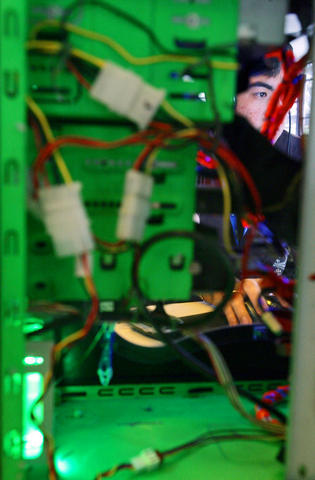Many gamers are alienated by computers, preferring instead consoles which offer low-cost installation-free entertainment -- and they don't require consistent upgrading with expensive components to play the latest games, either.
In return, PC gamers argue that the open platform allows for more creativity in terms of games released and player-created material, and also a constant edge in the technology stakes. But they've had to concede that the debacle surrounding the latest iteration of Microsoft's multimedia API, DirectX 10, hasn't done much for the platform's reputation.
DirectX is a collection of tools that facilitate communication between hardware and Microsoft operating systems; all Windows release since 95, and the Xbox and Xbox 360 operating systems, use it. Each DirectX release brings new graphics technologies and performance improvements, ideally leading to increasingly visually compelling software.

PHOTO: AFP
The arrival of DirectX 10 was much anticipated. Unfortunately, it's also been heavily criticized. DirectX 10 was released as an exclusive for Microsoft's latest desktop OS, Windows Vista, leaving Windows XP (and 2000) users comfortable with their current setup chagrined.
The phasing out of redundant operating systems is inevitable, but with DirectX 10's release, Microsoft has almost completely ended support in this department for everything other than Vista. And for non-enthusiast PC users, who might not be upgrading for a while, this is a serious handicap. Microsoft attracted ire for this decision; it was labelled everything from lazy programmers to extortionists.
Chas Boyd, DirectX's software architect, explains Microsoft's position: "DirectX 10 requires specific features of the Windows Vista operating system in order to take full advantage of graphics hardware, specifically the functionality offered by the new display driver model. The adoption period associated with any new technology can cause some users to feel left behind."
"We've done our best to limit complexity for users by assuring that all DirectX 10 titles are backwards compatible with DirectX 9 hardware and Windows XP. As Windows Vista becomes the platform of choice for PC gamers, we feel confident that Windows gamers will appreciate the quality and features Windows Vista brings to gaming, and to DirectX 10," Boyd said.
Certainly the API's new features have been praised by developers. Bernd Diemer, lead designer of Crytek's stellar Crysis -- arguably one of Vista's biggest selling points for gamers -- has nothing negative to say about it.
"DirectX 10 is designed to give a cleaner interface with lower CPU overhead and an extended feature set which allows complex rendering solutions to be achievable in real time," he said.
These improvements are undoubtedly a boon for developers, but what about consumers -- especially those without Vista? Diemer believes that the sales of DirectX 10-compatible hardware are evidence enough that those gamers will be moving to Vista simply so they can get the most out of their computer.
"A significant number of gamers are already moving to DirectX 10-capable hardware such as the nVidia Geforce 8800 series," he said, "so the real issue is whether they should move to Vista in order to fully exploit their hardware. The launch of Crysis is a clear signal that there's no better time to move to Vista than now," Diemer said.
Boyd agrees.
"Crysis has been almost universally declared the most visually advanced game available," he said, "due in no small part to Crytek's use of DirectX 10. Other titles including Gears of War for Windows, BioShock, World in Conflict and Flight Simulator demonstrate what DirectX 10 can offer to games in a variety of genres."
Further, Crytek has come under fire for disabling the "Very High" (maximum) visual settings in Crysis' DirectX 9 build, which is the one many XP users will be playing if their existing graphics card is up to it.
Some allege that this was an attempt to convince XP stalwarts that highest visual quality available in the game can only be produced with DirectX 10.
But this isn't strictly true; it's been discovered that it's possible to re-enable the maximum visual quality settings in Crysis with some simple editing of the game's configuration files. This makes the DirectX 10 and DirectX 9 versions of the game more or less on a par with each other, barring subtle visual tricks only DirectX 10 can achieve.
Boyd doesn't comment on this much-mooted design decision, but he does want to remind players to wait and see. "Right about now we are seeing performance parity between DirectX 9 and DirectX 10 implementations," he concedes, "and from here on DirectX 10 performance will grow. We are already seeing some image quality improvements due to DirectX 10's more precise specification of how the hardware should work, which helps both DirectX 9 and DirectX 10 games visually.
DirectX 10's advanced features will enable games to use visual techniques that would be more complicated to implement under DirectX 9. For example, improved interfaces allow higher scene complexity for richer, more detailed worlds at a given performance level. At a practical level, DirectX 10's more consistent feature set also means more games shipping sooner because of reduced game development times."
"It takes time for adoption to grow and the full realization of the potential to unfold. We've seen our development partners do some amazing things with DirectX 10, and with additional driver and hardware support, we're confident that DirectX 10 technology is on its way to changing the way the world looks at computer graphics," he said.
At this point, DirectX 10 appears to be more of a boon for developers than players. Should many of the gamers who've upgraded to DirectX 10-capable hardware (for performance reasons) upgrade to Vista so they can get everything they paid for?
As time draws on, as hard drives fail and need to be replaced and as more DirectX 10-geared software hits shelves, most gamers will eventually end up with Vista. But they'll never forget that it isn't easy being a PC gamer sometimes.

WAITING GAME: The US has so far only offered a ‘best rate tariff,’ which officials assume is about 15 percent, the same as Japan, a person familiar with the matter said Taiwan and the US have completed “technical consultations” regarding tariffs and a finalized rate is expected to be released soon, Executive Yuan spokeswoman Michelle Lee (李慧芝) told a news conference yesterday, as a 90-day pause on US President Donald Trump’s “reciprocal” tariffs is set to expire today. The two countries have reached a “certain degree of consensus” on issues such as tariffs, nontariff trade barriers, trade facilitation, supply chain resilience and economic security, Lee said. They also discussed opportunities for cooperation, investment and procurement, she said. A joint statement is still being negotiated and would be released once the US government has made

‘CRUDE’: The potential countermeasure is in response to South Africa renaming Taiwan’s representative offices and the insistence that it move out of Pretoria Taiwan is considering banning exports of semiconductors to South Africa after the latter unilaterally downgraded and changed the names of Taiwan’s two representative offices, the Ministry of Foreign Affairs (MOFA) said yesterday. On Monday last week, the South African Department of International Relations and Cooperation unilaterally released a statement saying that, as of April 1, the Taipei Liaison Offices in Pretoria and Cape Town had been renamed the “Taipei Commercial Office in Johannesburg” and the “Taipei Commercial Office in Cape Town.” Citing UN General Assembly Resolution 2758, it said that South Africa “recognizes the People’s Republic of China (PRC) as the sole

NEW GEAR: On top of the new Tien Kung IV air defense missiles, the military is expected to place orders for a new combat vehicle next year for delivery in 2028 Mass production of Tien Kung IV (Sky Bow IV) missiles is expected to start next year, with plans to order 122 pods, the Ministry of National Defense’s (MND) latest list of regulated military material showed. The document said that the armed forces would obtain 46 pods of the air defense missiles next year and 76 pods the year after that. The Tien Kung IV is designed to intercept cruise missiles and ballistic missiles to an altitude of 70km, compared with the 60km maximum altitude achieved by the Missile Segment Enhancement variant of PAC-3 systems. A defense source said yesterday that the number of

Taiwanese exports to the US are to be subject to a 20 percent tariff starting on Thursday next week, according to an executive order signed by US President Donald Trump yesterday. The 20 percent levy was the same as the tariffs imposed on Vietnam, Sri Lanka and Bangladesh by Trump. It was higher than the tariffs imposed on Japan, South Korea and the EU (15 percent), as well as those on the Philippines (19 percent). A Taiwan official with knowledge of the matter said it is a "phased" tariff rate, and negotiations would continue. "Once negotiations conclude, Taiwan will obtain a better